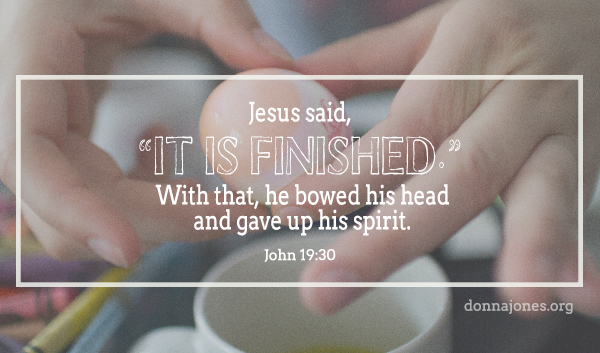What would you do if you knew you had one week to live?
Visit family? Travel? Make things right with a loved one? Call your friends?
Most of us will never know when it’s our last week of life. But Jesus did.
[bctt tweet=”He was born in a common stable and died with common criminals to save a world of common people.” username=”donnajonesspeak”]At just 33 years old he knew.
It was finished.
It’s hard for me to wrap my mind around the thoughts and feelings that must have swirled around his brain as he interacted with friends, family and even strangers during his last seven days of life on earth. Of course, they had no idea.
But he knew.
Was he sad? Scared? Happy? Relieved? Or did his feelings run the spectrum of human emotion?
What was it like for Jesus to live his final week?
His last Monday. His last Tuesday. His last Wednesday…
It got me thinking, what did Jesus do each day? And what can I learn from how he lived knowing he was going to die?
So I looked it up.
Since I thought you might want to know, too, I’ve included the events and verses below.
This Friday–Good Friday for us, crucifixion Friday for him–millions of believers from all over the globe will remember His death. On Sunday millions more will celebrate His resurrection. But from the now until then, let’s also remember His one
Last.
Week.
The Last Week
Note: numbers denote corresponding Bible passages (scroll to the end) where the details of Jesus’ last week are found. Try looking them up and read the accounts for yourself. I am. It’s great!
Saturday and Sunday
Jesus drew near to Jerusalem,1 arriving at Bethany six days before Passover,2 on Saturday. Jesus was anointed at Simon the leper’s house.3 On Sunday, a great crowd came to Bethany to see Jesus and he rode into Jerusalem on a donkey. They lined the streets waving Palm Branches, shouting “Blessed is He who comes in the name of the Lord!”.4 This is now known as Palm Sunday.
Monday
The next day 5 Jesus entered Jerusalem,6 visited the temple 7 and returned to Bethany. It was when the Passover lambs were selected. Likewise, the entry into Jerusalem was the day when Jesus presented himself as Israel’s Passover Lamb.
Tuesday
On the way from Bethany to Jerusalem 8, Jesus challenged the temple practice of selling on the premises.9 Some religious leaders began to plot ways to kill him. That evening Jesus left Jerusalem, presumably returning to Bethany.10
Wednesday
11 At the temple in Jerusalem, Jesus’ authority and wisdom was questioned by some religious leaders.12 That afternoon Jesus went to the Mount of Olives and delivered his discourse to those assembled.13 Two additional things occurred on that day: (1) Jesus predicted that in two days he would be crucified at the time of the Passover;14 and (2) Judas planned the betrayal of Jesus with some religious leaders.15
Thursday
Jesus and his disciples prepared the Passover lamb,16 and they had their seder meal together.17 Jesus shared heartfelt words with his disciples and offered an intercessory prayer in their behalf.18 They arrived at the Garden of Gethsemane, where Jesus suffered in agony awaiting what was to come.19 Later that night Jesus was betrayed and arrested.20 He was tried first by Annas and later by Caiaphas and other religious leaders.21
Friday
Early in the morning, Jesus was tried by the Sanhedrin, Pilate, Herod Antipas, and Pilate again.22 He was led to the cross and crucified at 9 a.m. and died at 3 p.m. and was buried later that day.23 Jesus died at the time when the Passover lambs were being sacrificed.
Saturday
Jesus’ body was in the tomb during the Sabbath, and the Pharisees hired Roman guards to keep watch of the tomb.24
Sunday
Christ was resurrected from the dead.25 His was the first of many resurrections to come, in which it was a type of first fruits offering. (First fruit offerings were made on the day after the Sabbath.)26
1. John 11:55
2 John 12:1
3. Matthew 26:6–13; Mark 14:3–9; John 12:1–8
4. John 12:9–11
5. John 12:12
6. Matthew 21:1–9; Mark 11:1–10; Luke 19:28–40; John 12:12–19
7. Matthew 21:10–11; Mark 11:11
8. Matthew 21:18–19; Mark 11:12–14
9. Matthew 21:12–13; Mark 11:15–17; Luke 19:45–46
10. Mark 11:18–19; Luke 19:47–48
11. Matthew 21:20–22; Mark 11:20–26
12. Matthew 21:23–23:39; Mark 11:27–12:44; Luke 20:1–21:4
13. Matthew 24:1–25:46; Mark 13:1–27; Luke 21:5–36
14. Matthew 26:1–5; Mark 14:1–2; Luke 22:1–2
15. Matthew 26:14–16; Mark 14:10–11; Luke 22:3–6
16. Matthew 26:17–19; Mark 14:12–16; Luke 22:7–13
17. Matthew 26:20–30; Mark 14:17–26; Luke 22:14–30
18. Matthew 26:30–35; Mark 14:26–31; Luke 22:31–39; John 15:1–18:1
19. Matthew 26:36–46; Mark 14:32–42; Luke 22:39–46; John 18:1
20. Matthew 26:46–56; Mark 14:43–52; Luke 22:47–53; John 18:2–12
21. Matthew 26:57–75; Mark 14:53–72; Luke 22:54–65; John 18:13–27
22. Matthew 27:1–30; Mark 15:1–19; Luke 22:66–23:25; John 18:28–19:16
23. Matthew 27:31–60; Mark 15:20–46; Luke 23:26–54; John 19:16–42
24. Matthew 27:61–66; Mark 15:47; Luke 23:55–56
25. Matthew 28:1–15; Mark 16:1–13; Luke 24:1–35
26. Leviticus 23:9–14; 1 Corinthians 15:23
From “A Chronological Look at How Jesus Spent his last Week Leading up to Passover”. www.jewsforjesus.org.
Adapted from Chronological Aspects of the Life of Christ by Harold W. Hoehner. Copyright 1977 by The Zondervan Corporation; 1973, 1974 by Dallas Theological Seminary. Used by permission of The Zondervan Corporation.



